|
1.
CENTRAL/ WEST AFRICA
Timber market remains fairly stable
Prices for West and Central African primary timber products remained largely unchanged in early March. The
market is reported as steady with shipments moving on schedule. The continued mild weather throughout Europe
and normal buying for early summer requirements is helping to keep markets stable. Moreover, the recent
upward trend in Asian prices, coupled with the ongoing tighter supply in that region, also gives confidence to West
African producers and shippers to maintain firm price levels.
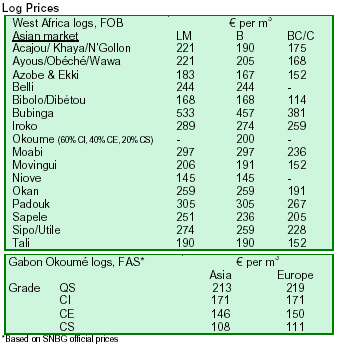
According to some reports, China is becoming slightly overstocked with okan logs. As a consequence, buyers and
agents may become tough over negotiations for near future shipments, with agents offering much lower prices for new
business. However, the situation seems to be temporary and not serious nor at risk of undermining the market
situation overall. Although there may be some normal price fluctuations according to the strength of demand for
certain species, it appears that the market will remain firm well into the second quarter.
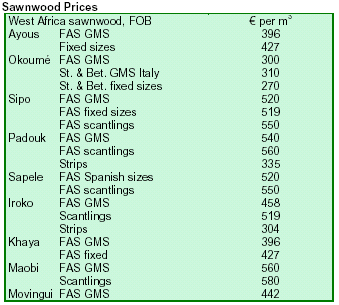
2. GHANA
Timber union joins call for relaxed levies
The Ghana government has been asked again to relax levies and charges in the timber industry so as to save the
industry from downturn and more layoffs. According to the Timber and Workers Union (TWU), the many levies
and charges associated to stumpage fees, ECOWAS and export levies in the timber production were killing the
industry. TWU urged the government to, as a matter of urgency, revive the industry to save more workers from
being fired. About 7,000 workers in the industry are estimated to have lost their jobs in the last semester of
2006. Mr Alex Kwabena Bonney, National Chairman of the TWU, said the levies and taxes were some of the
economic policies impacting negatively on the industry, relegating it to the bottom. Last year, the Ghana Timber
Millers Organization (GTMO) had called on the government to review its export levies and taxes to give
the industry a competitive edge (see TTM 11:18). According to some analysts, the fiscal scheme may have
contributed to the 7.6% decline in Ghana timber products exports in 2006.
Mr. Bonney said that the energy crisis had deepened the problems of the industry and appealed to workers to
devote more time to work till the crisis was over. He said workers in the industry should show more commitment by
working on Sundays when power supply was available since it would improve production tremendously.
Late in 2006, the Minister of Finance, Mr. Kwadwo Baah-Wiredu, charged the Ministry of Lands, Forestry and
Mines together with industrial representatives to form a technical committee to review the fiscal and financial
framework of the Forestry Commission, in particular, and the forestry sector in general to decisively address the
stakeholders¡¯ concerns (see TTM 11:23).
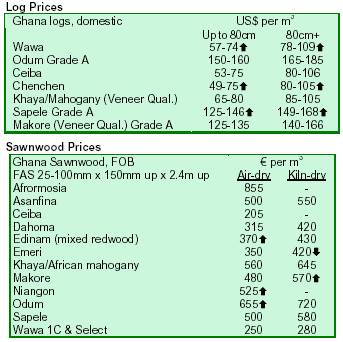

3.
MALAYSIA
Prices for plywood buoyant as demand remains steady
Prices for Malaysian timber products continued to climb, rising across the board in early March. Prices for plywood
remained buoyant as demand from Japan was steady. Sawntimber prices were picking up steadily as orders from
China and India showed no signs of relenting. Another significant market for Malaysian timber products is the
United Arab Emirates (UAE). More than $200 billion
worth of construction projects are already in the pipeline in the country. Analysts say that UAE is a market Malaysian manufacturers cannot afford to dismiss.
Malaysia to ask timber suppliers for proof of origin
Malaysia will ask its timber suppliers in other countries to provide certification on the origin of the wood. This would
facilitate Malaysian firms selling secondary processed wood products to Europe to show the certificates to their
buyers, according to the Plantation Industries and Commodities Minister, Datuk Peter Chin. The move is part of the Voluntary Partnership Agreement (VPA)
negotiations which are underway between Malaysia and the EU. Negotiators are discussing the details that need to
accompany timber products bound for Europe. Mr. Chin said this would ensure that Malaysia was not accidentally
purchasing smuggled or illegally-logged timber. He further said that European countries should make sure that
they purchased timber and timber-based products from countries that practiced sustainable forest management if
Malaysia signed the VPA. He added that the EU member countries must also be ready to pay more for the timber
products, as Malaysian manufacturers would incur additional costs.
Malaysian furniture exports expected to grow 7-9%
Malaysia's furniture exports are estimated to grow 7-9% in 2007, largely driven by demand for wooden furniture,
according to the Malaysian Deputy Minister of Plantation Industries and Commodities, Datuk Anifah Aman, at the
recently concluded Malaysian International Furniture Fair
(MIFF) 2007. Currently, wooden furniture, mostly rubberwood, accounted for 80% of total furniture exports
of 7.25 billion ringgit in 2006, he said. Malaysia is the ninth leading exporter of furniture in the world, with an
export value of $2.28 billion in 2006.
That 2007 projection may be tempered somewhat by two key weaknesses in the US housing market: the surplus of
homes in the market and unprecedented price gains. Another concern is rising mortgage defaults, especially in
the sub-prime sector, that could lead lenders and regulators
to choke off the credit that fed previous booms. The USA is Malaysia's leading export market for furniture,
accounting for up to a third of its exports.
Chinese furniture fairs attract growing audiences
Mr. Datuk said that the date change of the High Point furniture spring show in North Carolina would not affect
future MIFF exhibitions significantly. However, one major US retailer said he was skipping the shows in Singapore
and Kuala Lumpur this year. Jake Jabs, president and CEO of Englewood, Colorado-based American Furniture
Warehouse, has attended the ASEAN shows for several
years. But this year, he is planning to instead attend three China shows in Dongguan, Shenzhen and Guangzhou in
mid-March.
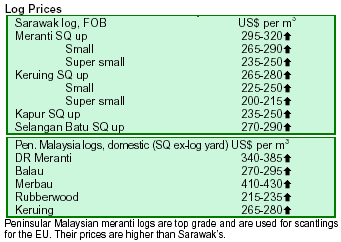
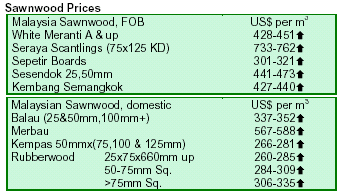
4.
INDONESIA
Indonesian prices surge as business resumes
Prices for Indonesian timber products resumed their upward trend, rising across the board in early March. The
Indonesian timber trade has recovered considerably as business resumed and returned gradually to normal.
Demand for plywood, MDF and other panel-products were particularly strong as buyers from China, South Korea and
Japan continued to express a strong interest in timber supply from Indonesia. Buyers feel that apart from low
production costs, efforts made by Indonesian authorities to combat illegal logging are gradually changing the
perception and image of Indonesia in importing countries.
However, the recent flooding in Jakarta and earthquake in Sumatra have caused law-enforcement efforts against
illegal logging and smuggling of such logs to thin out as manpower becomes overextended in on-going search and rescue operations.
Indonesia increases harvest quota
Indonesia's Minister of Forestry announced that the harvest quota for natural timber for 2007 would be
increased to 9.1 million m3, up almost 12% from 2006. However, sources close to the Ministry of Forestry
indicated that the quota for 2007 could be revised up to 12.4 million m3. The harvest quota was reduced between
2001 and 2005 (see chart) to achieve sustained yield and reduce over-capacity in lumber and plywood mills, which,
the government believes, has been achieved to a certain extent.
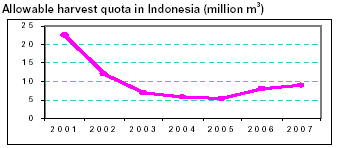
The Indonesian wood industry has shrunk in the last years
with the declining availability of logs. The number and production capacity of lumber and plywood mills have
plummeted over the period. The declining supply of Indonesian plywood contributed, in fact, to the sharp
increase of plywood prices in 2006. According to some analysts, the logging quota in 2006 (8.13 million m3) was
not fully used by local mills due to the reduced production capacity and financial difficulties. Some analysts thus
believe that the logging quota for 2007 would not necessarily lead to the revival of the Indonesian wood
industry.
Indonesia expands furniture export industry
Indonesia has one of the largest furniture export industries in the world. Based on Indonesian statistics, Maskayu
estimates that the Indonesian furniture sector comprises more than 3,500 companies with over two million
workers. Wooden furniture dominates the furniture sector, accounting for two-thirds of the total furniture exports.
The furniture industry is mainly concentrated in Java (notably Jepara,
Semarang, Solo and Surabaya), where furniture accounts for about 40% of
Java's total exports.
Jepara is particularly known for its crafted wooden furniture. Small firms market their products through a
network of furniture shops that sells locally. Exports are carried out through sub-contracting arrangements and
small enterprises play an active role in export.
The Indonesian furniture industry relies heavily on timber as its raw material with an annual requirement of 4.5
million m3. Although Indonesia is the world's second largest timber producer, the industry faces shortages of
raw materials. The main timber species for wood carving are teak, mahogany and sonokeling
(Dalbergia latifolia). Almost half of the total national rattan production is based
in Cirebon.
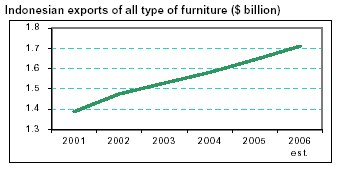
Wooden furniture accounts for the bulk of the exports
Indonesia is after Malaysia the world's second largest tropical exporter of furniture.
Indonesia's furniture exports
are expanding, growing from $1.58 billion in 2004 to $1.65 billion in 2005 (Maskayu, 2007). The chart above
shows the upward trend of Indonesian furniture exports. According to Maskayu, exports are poised to grow 3.5% in
2006 after growing at about 4% a year during the past five years. A higher growth of 5-7 % is expected in the coming
years. The chart below shows that wooden furniture accounts for three-quarters of the total furniture exports,
followed by rattan (21%), metal (2%) and bamboo (1%) furniture. The major markets for Indonesian wooden
furniture are the USA (24% of total exports), Japan (7%), the Netherlands and France (5% each). The USA is the main export destination for rattan furniture.
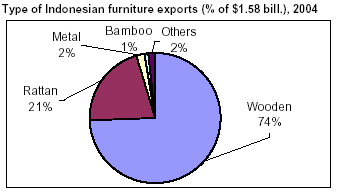
Challenges faced by the furniture industry
Indonesia faces several challenges in expanding its furniture exports. Firstly, despite its vast forest resources,
illegal timber logging and trade have affected the supply of timber to the furniture sector. This was aggravated by
the government's reduction of the logging quota for natural forests to 5.7 m3 in 2004 and 5.4 million m3 in
2005. Secondly, China, the world's largest producer and exporter of furniture, is gaining market share in key export
markets. Thirdly, increasing power and fuel costs have also raised operating costs, eroding
Indonesia's
competitiveness. Indonesia has sustained its
competitiveness by making progress in both quality and design enhancement.
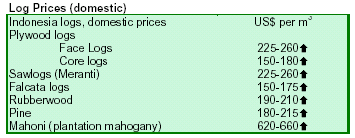
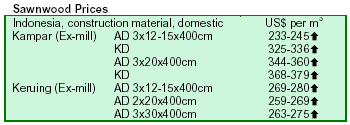
5.
MYANMAR
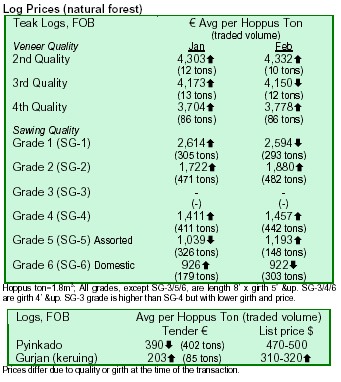
6. PAPUA
NEW GUINEA
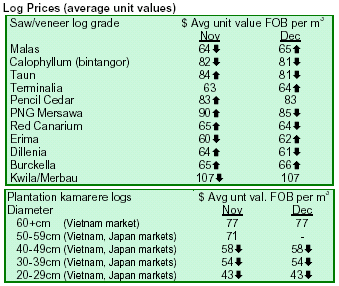
7. BRAZIL
Zoning used to reduce cattle-raising deforestation
The unplanned advance of cattle-raising in the nine states of the Brazilian Legal Amazon is causing illegal
deforestation and is one of the main concerns of the Ministry of the Environment (MMA). According to MMA
estimates, 75% of the deforested area in region is occupied with cattle raising, with about 70 million head of cattle,
one third of which in Mato Grosso. In order to reduce deforestation, the MMA has developed a new instrument,
the Economic-Ecological Zoning (ZEE). The ZEE is a state-mapping program used for regional planning that
defines the expansion of economic sectors, land occupation and protected areas for sustainable uses. The
states of Rondonia and Acre already use such instrument. The ZEEs serves to orient public policies and allow
private managers to make decisions based on potentialities and limitations of their activities. The utilisation of such
instrument is expected to break the unplanned advance of cattle ranches, as it indicates the zones allocated for such
activities. Moreover, with the zoning, people will be stimulated to utilise already deforested areas and access to
credit lines from MMA. The legal control will be carried out by IBAMA and state environmental agencies.
Brazil dismantles fraudulent transportation scheme
Brazilian federal police arrested 18 people involved in a scheme to issue licenses to transport illegal timber in the
Amazon, the Ministry of Environment said. Public servants, employees of the National Institute of
Environment, and timber traders were involved in the scheme in the northern state of Para. The dismantling of
the fraudulent licensing scheme was thanks to the new transport licensing system operating since September
2006. The computer-based system replaced the paperwork system, allowing frauds to be uncovered more quickly, the Ministry of Environment said.
Furniture exporters join to achieve economies of scales
The Business Centre of Cuiab¨¢
and Varzea Grande's Furniture Legal Productive Arrangement (APL), in Mato
Grosso, has obtained significant input cost savings as a result of a joint partnership between regional furniture producers. The purpose of the arrangement is to allow
micro and small exporting companies to achieve economies of scale in the purchase of production inputs.
Firms involved in the arrangement reduced input costs by an average 21% in 2005 and 27% in 2006, reaching up to
90% in some items. The arrangement has been implemented since 2005 in order to moderate the impact
of the continued devaluation of the US dollar against the Brazilian currency on
Brazil's international market competitiveness.
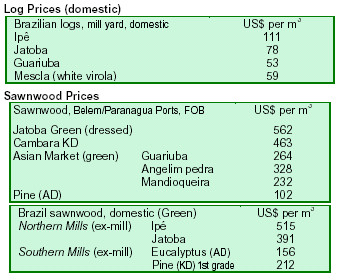
8. PERU
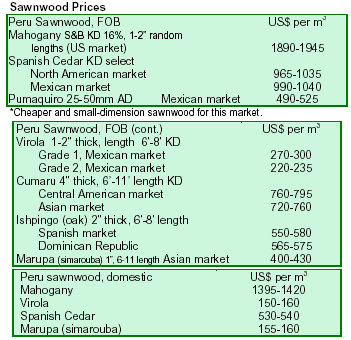
9. BOLIVIA
Widespread flooding delays forest operations
Bolivia has recently been hit by extensive flooding, particularly in the regions of Beni, Pando and Santa Cruz. Activities such as cattle raising and agriculture have been
the most affected, specially in Beni while forest activities have been affected to a lesser extent. Logging activities,
usually held between December and March, have been delayed in Beni and Pando. Heavy rains usually paralyze
forest operations in these regions during the rainy season due to poor road infrastructure. The delay in forest
operations in these regions, which account for about 25% of national wood extraction, is expected to be about three
weeks. In contrast, extraction activities have already resumed in some producing areas in Santa Cruz.
CFB prepares articles for Bolivia's new Constitution
The Forestry Chamber of Bolivia (CFB) is planning to propose some articles on the forestry regime for the new
Bolivian Constitution which is being prepared this year. To this end, a workshop was held with the participation of
forestry related institutions and companies from several regions of the country. The main conclusions of the
workshop included: the forest must be recognized as a strategic resource; a chapter on forest land must be
included in the new constitution; environmental services should be economically recognized as contributors to
forest value; and law enforcement must be improved to ensure sustainable forest management. The articles will be
prepared and submitted to the New Constitution Assembly for its consideration in early April 2007.

10. Guatemala
Teak accounts for the bulk of forestry exports
Guatemala exported $580,000 in teak products in 2006, accounting for 86% of total forestry exports. Two-thirds of
the teak export value consisted of sawnwood.

11.
Mexico
Mexico rapidly expands area of certified forests
Mexico increased its FSC certified forest area by 23.6% to 792,275 ha (mostly natural forests) in 2006, according to
Rainforest Alliance. This places Mexico third in Latin America, after Brazil (5.1 million ha) and Bolivia (2
million ha). The expansion of certified forest area was consistent with the global trend, according to the UNECE
and FAO's Forest Products Annual Market Review 2005-
2006. The world's certified forest area grew 12% in 2006. Certified forests are mainly located in six of
Mexico's 32
states, namely Durango (374,981 ha), Chihuahua (173,069 ha), Oaxaca (109,894 ha), Quintana Roo (113,057 ha),
Guerrero (14,784 ha) and Michoacan (6,487 ha), according to Rainforest Alliance. Tropical forests account for 14% of the total certified forest area (all in Quintana
Roo) while temperate forest account for the balance.
12.
Guyana

|